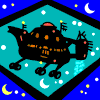
Science Fiction Anthropomorph: Spaceships can have 'ship's-rats' of a new variety: Twaydaw is an off-ship scout, much like a lightly-armed space-marine, or maybe like a "redshirt" with some survival sense.
Category All / General Furry Art
Species Rat
Size 480 x 800px
File Size 33.4 kB
The ship'srat looks back down and finishes adjusting her holster strap and fusses a bit with tucking it around that pants cuff. You may notice while this is going on, that both ears are swiveled in your direction, and she may even be smiling slightly more. She straightens up, glances down at the holster, and then towards the length the cross-corridor. Her right hand comes up and touches her hat-brim (maybe adjusting it?), and then there is a quick glance and slight smile at you before she looks away and starts to step-off, continuing down the side-corridor.
(If your fox-ears are large enough you can hear her sub-vocalizations: )
("Well, I was sure going to look port-sharp on this watch! Here I end up looking like a gigged recruit tucking in my tubing in front of a guest! A Chinese fox?! Those ears! What does <Wu Hu> mean in Chinese, anyway? Would Ship know that? <Wu huuu?> <Wuuuu-huuuu?> Why can't I stop trying to smile?! {Subvocal Twaydaw to Ship: What is the Chinese translation of Wuu...Wait. Ears. EARS!... Oh-SHIP!! Close Subvocal}.... ")
(If your fox-ears are large enough you can hear her sub-vocalizations: )
("Well, I was sure going to look port-sharp on this watch! Here I end up looking like a gigged recruit tucking in my tubing in front of a guest! A Chinese fox?! Those ears! What does <Wu Hu> mean in Chinese, anyway? Would Ship know that? <Wu huuu?> <Wuuuu-huuuu?> Why can't I stop trying to smile?! {Subvocal Twaydaw to Ship: What is the Chinese translation of Wuu...Wait. Ears. EARS!... Oh-SHIP!! Close Subvocal}.... ")
My Future History, the period of human interstellar space before Albedo, would have both Spacers, genetically modified people, designed for space work, and a ship's cat, rat, or dog, genetic artifacts, to cover unknown contingencies, that regular humans might not be able to cope with.
I think that would work well in many practical scenarios with human/anthro characters. Like the abilities of scent discrimination in canines, and hearing and fast optical processing in felines. I've also thought that some crewmembers of much smaller size might be useful in small ship spaces, like repair access and installation.
In this space-opera case, 'Buttermilk' would be within human-standard size and near human physical build. (Perhaps based on a human-form template?) Besides scouting, she might also have to have the physical strength of a standard human size. (The original reasons for the physical anthro-form may have been set up for other purposes, many generations before.)
The physical form may not have been genetic-engineered for being a form of space marine, but once the form was set (many generations ago), it was later discovered to be useful in this military role.
In this space-opera case, 'Buttermilk' would be within human-standard size and near human physical build. (Perhaps based on a human-form template?) Besides scouting, she might also have to have the physical strength of a standard human size. (The original reasons for the physical anthro-form may have been set up for other purposes, many generations before.)
The physical form may not have been genetic-engineered for being a form of space marine, but once the form was set (many generations ago), it was later discovered to be useful in this military role.
Influenced by the several pet rats my sister had.
For all the 'rat' stereotypes we're supplied with, I was impressed with the realization that the rats had individual personalities, and recognized us humans as large, distinct entities. They could comprehend a Huge Human. (Compared to many other small rodents who seemed to only see and interact with the the hand holding a treat to take.) Rats were also incredibly brave in systematic exploring. Obviously compelled to thoroughly check out their surrounding environment. It could be more important than a rat treat. (Perhaps that exploring was only to look for a God-Hand holding a cornucopia of Heavenly Treats, or to find Uncle Scrooge's RatFood Bin... Yet one could see them make decisions on where best to go next, and check us humans out for our reaction to their actions.)
"Buttermilk" is supposed to be near-human-standard size, but I agree - your analysis is spot-on.
For all the 'rat' stereotypes we're supplied with, I was impressed with the realization that the rats had individual personalities, and recognized us humans as large, distinct entities. They could comprehend a Huge Human. (Compared to many other small rodents who seemed to only see and interact with the the hand holding a treat to take.) Rats were also incredibly brave in systematic exploring. Obviously compelled to thoroughly check out their surrounding environment. It could be more important than a rat treat. (Perhaps that exploring was only to look for a God-Hand holding a cornucopia of Heavenly Treats, or to find Uncle Scrooge's RatFood Bin... Yet one could see them make decisions on where best to go next, and check us humans out for our reaction to their actions.)
"Buttermilk" is supposed to be near-human-standard size, but I agree - your analysis is spot-on.

 FA+
FA+














Comments